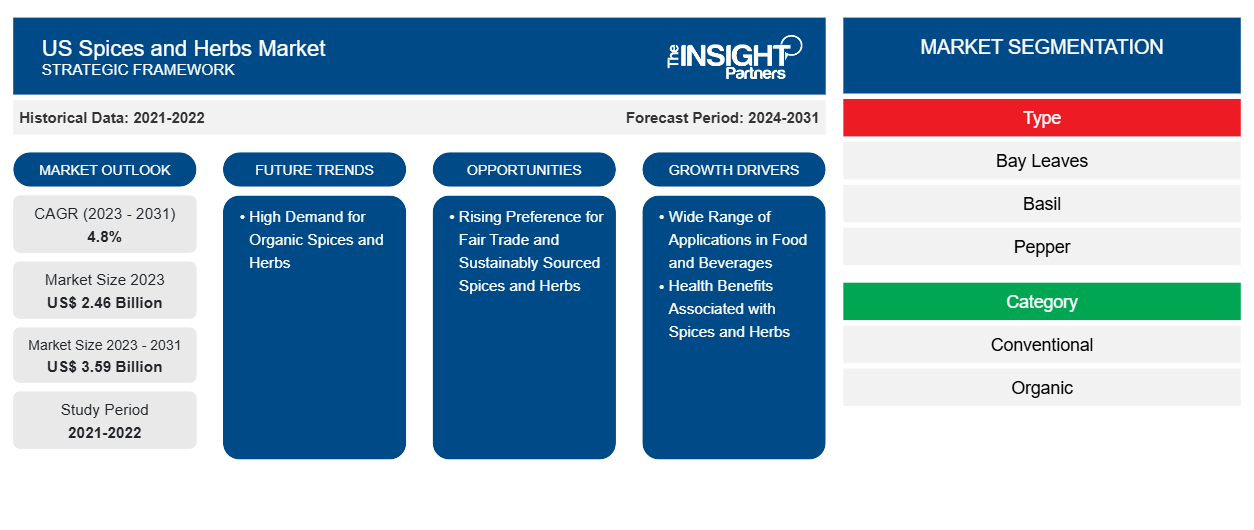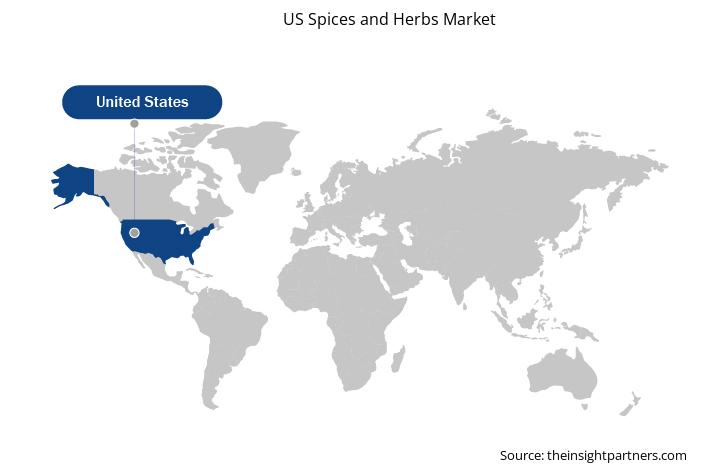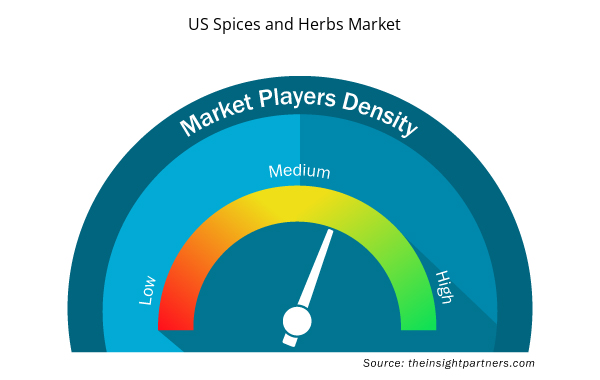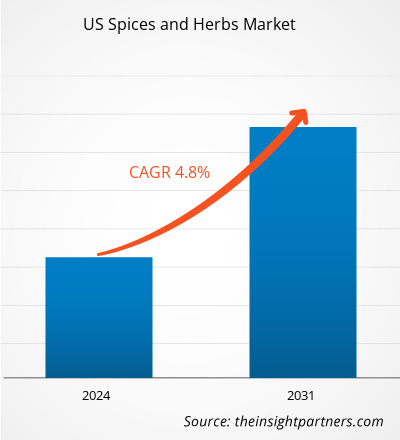The US spices and herbs market is projected to grow from US$ 2.46 billion in 2023 to US$ 3.59 billion by 2031; the market is expected to register a CAGR of 4.8% during 2023–2031. Increasing use of herbs and spices in the food & beverages industry in the US and rising awareness regarding the health benefits of herbs and spices are likely to remain key trends in the market.
US Spices and Herbs Market Analysis
The popularity of home cooking plays a significant role in the increased demand for spices and herbs to create diverse and flavorful meals. Food blogs, cooking shows, and posts on social media platforms, including YouTube, Facebook, and Instagram, inspire consumers to make multicuisine dishes at home. A wide range of spices and herbs is required to make such recipes, which fuels the US spices and herbs market growth. Owing to the rising awareness regarding the benefits of organic and clean food, consumers are mindful of the quality and sourcing of food products and prefer organic and non-GMO products. This shift propels the demand for organically grown spices and herbs as they align with the values of sustainability and health consciousness prevalent among today's consumers. In addition, the country's well-established food & beverages industry and the presence of a large number of food service chains, such as McDonald's, Burger King, KFC, Pizza Hut, Wendy's, Domino's Pizza, and Taco Bell, fuel the growth of the US spices and herbs market.
US Spices and Herbs Market Overview
Spices and herbs are used for culinary and medicinal purposes. Spices enhance the flavor, aroma, and color of food and beverages. Herbs and spices consist of various parts of plants, including rhizomes, bulbs, barks, flower buds, stigmas, fruits, seeds, and leaves, cultivated for their aromatic, pungent, and otherwise desirable substances. Technically, herbs come from aromatic plants grown in the temperate zone, while spices are products of tropical plants. Spices and herbs are rich in phytochemicals, which are healthful plant chemicals. They possess anti-inflammatory, antioxidant, anticarcinogenic, antitumorigenic, and cholesterol- and glucose-lowering activities, as well as properties that affect cognition and mood. Additionally, herbs and spices have been widely valued for centuries for their healing properties. Furthermore, the use of certain spices and herbs alone, or in blends, can replace or reduce salt and sugar in foods, contributing to their increased demand.
Customize This Report To Suit Your Requirement
You will get customization on any report - free of charge - including parts of this report, or country-level analysis, Excel Data pack, as well as avail great offers and discounts for start-ups & universities
US Spices and Herbs Market: Strategic Insights

- Get Top Key Market Trends of this report.This FREE sample will include data analysis, ranging from market trends to estimates and forecasts.
Customize This Report To Suit Your Requirement
You will get customization on any report - free of charge - including parts of this report, or country-level analysis, Excel Data pack, as well as avail great offers and discounts for start-ups & universities
US Spices and Herbs Market: Strategic Insights

- Get Top Key Market Trends of this report.This FREE sample will include data analysis, ranging from market trends to estimates and forecasts.
US Spices and Herbs Market Drivers and Opportunities
Health Benefits Associated with Spices and Herbs Favors Market Growth
In recent years, health awareness has increased significantly among the US population. Bioactive compounds present in spices and herbs are responsible for improving health when they function for antioxidant, anti-inflammatory, anticancer, antimicrobial, and antiviral activities. National Foundation for Cancer Research mentions that certain herbs and spices have been proven to prevent cancer, lower cholesterol levels, and improve overall human health. In folk medicine, turmeric is used for stomach, gynecological, liver, and blood diseases. It has also been suggested for treating proinflammatory diseases, cancer, diabetes, obesity, and atherosclerosis.
Consumers are becoming health-conscious and seeking natural alternatives to enhance their well-being. Herbs such as basil and oregano are rich in vitamins and minerals, contributing to improved immunity and overall health. Ginger and garlic aid in reducing stomachache and nausea. Similarly, lemongrass has antifungal and antibacterial properties. Lemongrass contains inflammation-fighting compounds such as isoorientin, chlorogenic acid, and swertiajaponin. Moreover, consumers in the region are significantly consuming chamomile herbal tea. It aids in muscle spasms, menstrual disorders, insomnia, and ulcers. Thus, the rising awareness regarding the health benefits of spices and herbs bolsters the US spices and herbs market growth.
Rising Preference for Fair Trade and Sustainably Sourced Spices and Herbs to Create Significant Opportunities
Over the past few years, sustainability has become an essential aspect of the food industry. Consumers seek products that reflect ethical treatment and fair compensation for farmers and workers. Moreover, they are looking for products with a low environmental impact. Manufacturers also focus on biodegradable or recyclable packaging, low carbon emissions throughout the process, and raw material procurement from local farmers. Traders that purchase these products on fair trade terms must pay producers a premium of 15% on top of the commercial sales price. In the US, most spices and herbs are imported from Asian countries. Therefore, buyers in the US embrace sustainable sourcing to safeguard the security of supply chains and maintain the quality of the products.
Rising awareness about environmental impact, consumer demand, and international regulations have prompted various application industries to seek sustainably produced and fair-trade certified ingredients. Frontier Co-op. and Curio Spice Co. are among a few manufacturers in the US that offer fair trade certified products ensuring the sustainability of the products to consumers. Further, the growing availability and visibility of fair trade and sustainably sourced spices and herbs in the mainstream market have facilitated this shift. Major retailers and specialty food stores are expanding their product lines to include ethically sourced options, making it easier for consumers to make conscientious choices. Marketing campaigns and labeling initiatives can play a key role in educating consumers about the benefits of these products. Also, manufacturers of spices and herbs adopt fair-trade strategies to expand their product portfolio to fulfill the increasing demand for sustainably sourced and fair-trade spices and herbs. Thus, the rising awareness and preference for fair-trade and sustainably sourced ingredients would provide lucrative opportunities for the US spices and herbs market during the forecast period.
US Spices and Herbs Market Report Segmentation Analysis
Key segments that contributed to the derivation of the US spices and herbs market analysis are type, category, form, and end-use.
- Based on type, the US spices and herbs market is segmented into bay leaves, basil, pepper, chilies, cumin, coriander, garlic, nutmeg, turmeric, fennel seeds, cinnamon, and others. The other segment accounted for the largest share in 2023.
- The market, by category, is bifurcated into conventional and organic. In 2023, the conventional segment held a larger market share.
- In terms of form, the market is segmented into whole, powder/ground, and flakes. The whole segment held the largest share in 2023.
- Based on end use, the US spices and herbs market is segmented into food processing, food retail, and food service. The food processing segment accounted for the largest market share in 2023.
US Spices and Herbs Market Share Analysis by Region
The regional scope of the US spices and herbs market report is mainly divided into Northeast, Southwest, West, Southeast, and Midwest. The Southwest is expected to record the highest CAGR during the forecast period. The demand for spices and herbs is increasing in the region due to the region's rich culture, heavily influenced by Mexican and Native American culinary traditions featuring a wide array of spices and herbs. The popularity of Southwestern cuisines, known for their bold and complex flavors derived from ingredients such as chili peppers, cumin, cilantro, and oregano, drives the demand for spices and herbs in the region. Also, the growing Hispanic population in the region brings a strong demand for traditional spices used in Mexican and Latin American cooking. The burgeoning interest in health and wellness also contributes to the demand for spices and herbs, as consumers in the Southwest US embrace the nutritional benefits of spices and herbs, such as their anti-inflammatory and antioxidant properties. Furthermore, the region's vibrant food trends, emphasizing the use of natural ingredients, encourage the use of diverse spices and herbs, further fueling the US spices and herbs market growth.
US Spices and Herbs Market Regional Insights
The regional trends and factors influencing the US Spices and Herbs Market throughout the forecast period have been thoroughly explained by the analysts at Insight Partners. This section also discusses US Spices and Herbs Market segments and geography across North America, Europe, Asia Pacific, Middle East and Africa, and South and Central America.

- Get the Regional Specific Data for US Spices and Herbs Market
US Spices and Herbs Market Report Scope
| Report Attribute | Details |
|---|---|
| Market size in 2023 | US$ 2.46 Billion |
| Market Size by 2031 | US$ 3.59 Billion |
| Global CAGR (2023 - 2031) | 4.8% |
| Historical Data | 2021-2022 |
| Forecast period | 2024-2031 |
| Segments Covered |
By Type
|
| Regions and Countries Covered | US
|
| Market leaders and key company profiles |
US Spices and Herbs Market Players Density: Understanding Its Impact on Business Dynamics
The US Spices and Herbs Market market is growing rapidly, driven by increasing end-user demand due to factors such as evolving consumer preferences, technological advancements, and greater awareness of the product's benefits. As demand rises, businesses are expanding their offerings, innovating to meet consumer needs, and capitalizing on emerging trends, which further fuels market growth.
Market players density refers to the distribution of firms or companies operating within a particular market or industry. It indicates how many competitors (market players) are present in a given market space relative to its size or total market value.
Major Companies operating in the US Spices and Herbs Market are:
- McCormick & Co Inc
- Badia Spices, Inc.
- B&G Foods Inc
- Goya Foods Inc
- Sauer Brands
- Pacific Spice Company, Inc.
Disclaimer: The companies listed above are not ranked in any particular order.

- Get the US Spices and Herbs Market top key players overview
US Spices and Herbs Market News and Recent Developments
The US spices and herbs market is evaluated by gathering qualitative and quantitative data post primary and secondary research, which includes important corporate publications, association data, and databases.
US Spices and Herbs Market Report Coverage and Deliverables
The “US Spices and Herbs Market Size and Forecast (2021–2031)” report provides a detailed analysis of the market covering below areas:
- US spices and herbs market size and forecast for all the key market segments covered under the scope
- US spices and herbs market trends, as well as market dynamics such as drivers, restraints, and key opportunities
- Detailed Porter’s Five Forces and SWOT analysis
- US spices and herbs market analysis covering key market trends, country framework, major players, regulations, and recent market developments.
- Industry landscape and competition analysis covering market concentration, heat map analysis, prominent players, and recent developments for the US spices and herbs market
- Detailed company profiles
- Historical Analysis (2 Years), Base Year, Forecast (7 Years) with CAGR
- PEST and SWOT Analysis
- Market Size Value / Volume - Global, Regional, Country
- Industry and Competitive Landscape
- Excel Dataset



Report Coverage
Revenue forecast, Company Analysis, Industry landscape, Growth factors, and Trends

Segment Covered
This text is related
to segments covered.

Regional Scope
North America, Europe, Asia Pacific, Middle East & Africa, South & Central America

Country Scope
This text is related
to country scope.
Frequently Asked Questions
Growing demand for organic spices and herbs is expected to emerge as a future trend in the market during the forecast period.
McCormick & Co Inc; Badia Spices, Inc.; B&G Foods Inc; Goya Foods Inc; Sauer Brands; Pacific Spice Company, Inc.; US Spice Mills, Inc.; Great American Spice Company; Baron Spices & Seasonings; and Harris Spice are among the key players operating in the market.
The market is expected to register a CAGR of 4.8% during 2023–2031.
Rising applications in the food & beverage industry and health benefits associated with spices and herbs drive the market growth.
Trends and growth analysis reports related to Food and Beverages : READ MORE..
The List of Companies - US Spices and Herbs Market
- McCormick & Co Inc
- Badia Spices, Inc.
- B&G Foods Inc
- Goya Foods Inc
- Sauer Brands
- Pacific Spice Company, Inc.
- US Spice Mills, Inc.
- Great American Spice Company
- Baron Spices & Seasonings
- Harris Spice

 Get Free Sample For
Get Free Sample For